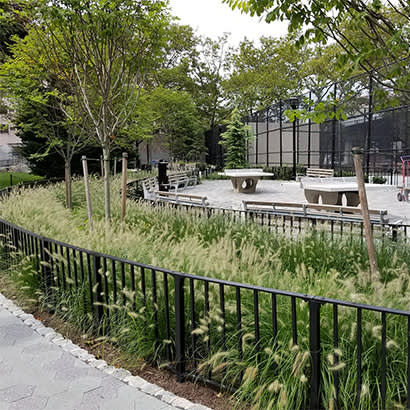
For an enhanced digital experience, read this story in the ezine.
New York City Department of Parks and Recreation cares for more than 30,000 acres of parkland throughout the five boroughs of New York City. From small pocket parks and neighborhood playgrounds to large regional parks, beaches, marshes, forests and natural areas, thoughtful planting design has been a key component of ensuring the city’s green spaces are thriving and resilient.
This approach has become even more important during the coronavirus (COVID-19) pandemic. As more New Yorkers looked to parks as sanctuaries for physical and mental well-being, the fiscal crisis led to a loss of seasonal maintenance and operations staff. By designing parks to anticipate such changes and needs, cities can help people engage with public spaces while supporting the staff who care for them. Following are design principles and considerations that guide our approach to planting:
1) Bring the joys of the natural world to all New Yorkers.
Seasonal variation and sensory qualities are primary considerations in plant selection. Texture, sound and fragrance can change a familiar place from season to season. A mass of daffodils or catmint, yellow witch hazel, a grove of cherry trees, the rustle of leaves or fallen sweetgum balls offer small joys in an urban environment.
2) Plant with operational and maintenance challenges in mind.
The design of our parks must anticipate maintenance and operations constraints. Replacing trees and plants post-construction is unlikely and maintaining a complex plant bed can be challenging. To mitigate these challenges, we plant fewer, but larger, more densely spaced and resilient plants of the same species. This approach reduces areas for weeds to establish and facilitates weeding regardless of skill and experience. Often, an open green park with an abundant, well-placed canopy and flowering understory trees can have a bigger impact than fussy plant beds. New trees planted in the lawn with each one surrounded by a small mulch circle can protect the young bark from mower damage.
3) Consider historical context and design integrity.
Many older parks in New York City have intact designs with historical significance. For capital projects in these historic parks, we consider the original design, giving careful study to the spacing, forms and arrangements of the original design features. This analysis guides the design approach. When working in such landscapes, the contemporary designer should be aware of this design history and use it to create continuity between past and present. An excellent example of this principle at work can be seen in the recent redesign of Rainey Park, which, while being wholly contemporary, is rooted in the design vocabulary of the past.
4) Protect existing trees and increase the urban tree canopy.
The addition of new trees generates multiple benefits, including the increase of human comfort, reduction in urban heat island effect, uptake of stormwater and improvement in air quality. Landscape architects design new park sites carefully to protect the critical root zones of existing trees, often opening larger areas of soil around the tree in previously paved spaces. New trees are sited strategically, paying attention to sun patterns, so there is shade throughout the day on benches, pavements and play areas.
5) Support biodiversity and enhance the proportion of native species.
Acres of city property with important intact ecosystems are protected in natural areas. Only native plants are used when planting in these areas. Elsewhere in the city, we are working to increase the proportion of native plants that will do well in existing conditions. The Native Species Planting Guide for New York City offers a resource for using native plants.
Nancy Prince, RLA, ASLA, is Chief of Landscape Architecture for the New York City Department of Parks and Recreation. Judy Tung, RLA, is Senior Project Manager for Design for the New York City Department of Parks and Recreation.


